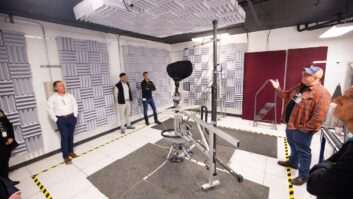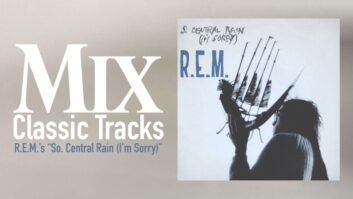Soundelux Joins in Sound-for-Picture ConsolidationThe sound-for-picture market has traditionally had room both for facilities operated by the major studios and for independent production houses. Many of these independents are far from scrappy upstarts, with several having been fixtures on the scene for decades. But in recent years, the trend has been to move from independence toward interdependence – not with the major studios but with each other. Names such as Pacific Ocean Post (POP) and Digital Sound & Picture (DSP), for example, last year came under the umbrella of Four Media Company (4MC), while Todd-AO bought out Sound One, the premier re-recording facility in New York City. Within the last few months, these companies have in turn been swallowed up by Liberty Media, an AT&T-owned company with interests in a broad range of video programming, communications, technology and Internet businesses in the United States, Europe, South America and Asia.
The newly acquired 4MC and Todd-AO operations – to be managed under the name Liberty Livewire – represent only part of Liberty’s game plan for asserting itself as a major post player. Another big piece of the puzzle is Soundelux Entertainment Group, including Soundelux Hollywood, Signet Soundelux Studios (formerly Motown Hitsville), Vine Street Studios and Modern Music, as well as Soundelux Audio Publishing (books-on-tape), Soundelux Microphones, and The Hollywood Edge sound effects library. The company’s divisions in the location-based entertainment field, such as Soundelux Showorks and Media Technology Source, are not included in the Liberty acquisition.
A JIGSAW FITLike the Todd-AO takeover, the Liberty/Soundelux agreement was first announced in July 1999, followed in November by news of the 4MC deal. Finally, on July 20, 2000, the last piece of the puzzle fell into place when papers were signed and Soundelux officially became a part of Liberty Livewire Audio. Lon Bender, who co-founded Soundelux in 1982 with partner Wylie Stateman, has been appointed president of the new company; Stateman has been named executive vice president. The result may seem monolithic at first glance, but Stateman points out that each of the companies that now make up Liberty Livewire has a different orientation.
“4MC is very big into television, DVD mastering and commercial post-production,” Stateman says. “Todd-AO is very much focused on film-mixing facilities and finishing facilities throughout L.A. and the country, including Sound One. And Soundelux is really heavily into the editorial and sound design aspects of the process. So we’re really quite a compatible – complementary – jigsaw fit, as opposed to having significant overlaps.”
For his part, Bender adds that the combined business will be able to address not only more types of work within the television and film industries, but also work at more levels of the business. “It’s going to increase our capacity at both the high end and low end, as well as in television,” he says. “They have some wonderful mixing facilities at Todd-AO and Sound One that are high-end facilities with Neve DFC consoles, and they have other mixing stages that will help expand our capacity beyond the two mixing stages we currently have at Vine Street. So we’re going to go from two mixing stages to over ten, plus all the added Foley and ADR recording capabilities that we’ll have.”
To give a feel for how the consolidation will broaden the reach of the facilities involved, Bender compares the volume of work at Soundelux alone with that of the companies together. “Right now,” he says, “I’d say Soundelux is probably doing about ten or 12 sound effects editing projects, and probably four or five mixing projects – mixing a couple of movies plus music mixing. We’re doing production on five or six Hollywood Edge discs per month, and we produce two audio books per month. And we’re doing music editing on probably 15 movies right now. We’re also doing work on six or seven different commercials and probably three or four CD-ROM games.”
Considering Soundelux’s involvement in currently playing films, including The Patriot, The Perfect Storm, M:I-2 and Gladiator, many of the movies on Bender’s in-progress list are likely to be tomorrow’s top attractions. But impressive as Soundelux’s business sounds by itself, it will be dwarfed when Livewire is fully constituted. “We are already working together with the other companies,” Bender continues, “and I was in a business-development meeting yesterday with DSP and 4MC and Sound One. I believe I counted close to 50 film projects alone that are simultaneously going on. And that wasn’t even including the music editing.”
Bender says there’s little risk that the concentration of production power in Livewire’s hands will amount to a sound-for-picture monopoly. “We went through the disclosures to the Justice Department and the SEC, and they had no problems whatsoever,” he says. “It may seem like Livewire’s going to be the only game in town, but the studios themselves are such big entities when it comes to doing sound work. Sony, Universal and Warner Bros. all have extensive mixing and editing capabilities, and Paramount has extensive editing capabilities. And of course, there’s Skywalker up north, which has mixing and editing and the other independent companies. So, we’re nowhere near having to worry about that sort of thing.”
ECONOMIES OF CONNECTIVITYGiven the success both Bender and Stateman enjoy as supervising sound editors on top-name films, the pair might well have been tempted to simply pocket their profits from the estimated $90 million sale and work as independents. But even if Liberty were to have allowed it, the partners both seem too excited by the potential of Livewire to walk out now. The interest they express has less to do with the size of the new entity than the way it is expected to operate.
“What we’re trying to do,” Stateman explains, “is to combine talent with the Liberty Media/AT&T backbone, and produce the next-generation post-production operation.” The backbone is central to this vision. “We believe that both picture and sound will travel across a networked grid,” he continues, “so that music, sound effects, dialog work or even graphics and animation can be shared and transferred from one facility to the next. We want a lot of the geographic barriers to disappear through the aid of very high-bandwidth networking systems. I imagine a time when someone can pull picture or sound across the network, anywhere locally in Los Angeles, or anywhere across the country, or across the world.”
The idea is reflective of technology trends in business at large, but Bender believes it is particularly applicable in creative fields. “Our industry is so reliant on the presence of creative people in the process,” he says. “The Internet and some of these local-area networks are allowing creative people to be in touch with each other instantly without them having to move physically from one location to the next.”
In addition to connecting talent without travel, another benefit of the envisioned network will be that materials will be easily accessible to people in different places. “The network isn’t necessarily going to change the work people do,” Bender says. “If they’re editing a specific sound, or mixing a specific sound, the network isn’t going to affect how long it takes them to do the editing portion or the mixing portion. But it is going to affect how long it takes them to get the source material and to deliver the completed material. Those two disconnect moments of getting raw material to an editor and then getting it to the mixing environment once they’ve edited it are huge inefficiencies in the business today. We hope to correct that through an extensive network between all of our facilities.”
From a business standpoint, Bender adds, the network will also allow more flexible allocation of human resources and facilities. “Through an integrated-scheduling system,” he says, “we’ll be able to look at any of our facilities nationwide on any given day and use our facilities in an extremely efficient manner. A vast part of our work is done without clients present, particularly in the preparation process. We can do recording at any given location or editing – the things that we can control without a client being impacted.”
While he’s enthusiastic about the benefits, Bender is careful to clarify the limits of this integrated approach to post. “I wouldn’t want to give the impression that our goal is to do all our work without our clients present,” he says. “We’re not planning to move mixing around based on daily availability.”
EVERYWHERE AT ONCEAs an example of how the integration of facilities might play out for a specific project, Bender refers to his work on the upcoming Schwarzenegger vehicle, Roger Spottiswoode’s The 6th Day. “We’re doing ADR in New York at Sound One and also at Todd-AO Bundy,” he says. “We’re going to do sound effects and dialog editorial at Soundelux and 4MC and Foley at Vine Street Studios as well as Todd-AO West. Then, we’re going to do the final mixing at Todd-AO West.”
The project demonstrates the advantage, Bender says, of being able to be in many places at once. “We’re able to be near the client, who’s located adjacent to the Todd West facility,” he says. “We’re able to offer mixing right next to their cutting rooms, but we’re also able to go to where actors are in New York and in Los Angeles to deliver a stage to them to do their recording. And we can also use our creative talent at different locations where it isn’t necessary for the client to be close to them. So it’s a full-range operation, this one.”
Bender says that Soundelux is already using a server to connect editorial facilities on Hollywood Boulevard with mixing at Vine Street Studios. “We currently use it to deliver sounds to a local playback format,” he says, “and then playback for mixing sessions off the local drives.” Another model for the networking approach that Livewire will take is found at Digital Sound & Picture. “The connectivity that we have planned,” Bender says, “is based on an expansion of John Ross’ original concepts that he’s worked out very nicely between DSP and 4MC.”
The downside to Livewire’s strategy of placing so much emphasis on networking is that it exacerbates a major technical hurdle the new company faces in integrating its various parts. “Currently,” Bender explains, “we’re using different editing environments between the facilities we have: Pro Tools, WaveFrame, Akai and Fairlight. So we can’t move material around in a form that is usable in all of the editing environments. They don’t speak the same language.
“Our goal is to be on one platform, ultimately,” Bender continues. “I can’t say which platform that will be. But one of our challenges is going to be to select and implement a standard editing platform throughout our facilities. That will also relate to mixing platforms.”
Bender hastens to add that the integration process will not be about engineering Livewire’s competitors out of the picture. “Soundelux has, historically, been fiercely independent of mixing facilities,” he says, “and Todd-AO has been fiercely independent as a mixing facility for 20 years. So part of our intrinsic model is to interact with other facilities for both editing and mixing. We don’t have any plans whatsoever to be a closed environment where we would only do shows where we cut everything and mix everything ourselves. We’ll be an open-mixing facility for outside companies to bring their work to, and an open-editorial service that will mix at other facilities.”
CORPORATE AND COREThe new company will apparently be open as well to work in areas beyond the entertainment sector, where the individual facilities have been focused so far. The network is key here also because it allows geographic dispersion – even to markets far afield of entertainment centers – without losing access to top-flight talent. Stateman mentions high-end corporate work as being an attractive target for this kind of expansion.
“In the future,” he says, “all large corporations will be producing some kind of multimedia information, whether it’s for internal or external use. It will need to be produced with high-quality graphics and animation and with high-quality audio – voice-over and music and sound effects. And it will need to be produced in foreign languages for those multinational companies. We believe that multimedia production is going to explode over the next several years. We have the experience, and we would like to have the footprint – all over the country and all over the world – to do the highest-quality work available for premier customers.”
Stateman isn’t daunted by the fact that churning out a high volume of high-end multimedia is not necessarily a top priority for the average corporation today. “Every corporation has at least one year-end production,” he says. “It may be their fall lines, their new model year for cars, a back-to-school line or the launch of a new product. A client that has a once-a-year need is the type of client that I’m looking for, because they will not build an in-house department to rise to that occasion. They’ll seek an outside service to really do something special, as opposed to having a daily need.”
Nonetheless, Stateman acknowledges that the core of Livewire’s business will likely remain the servicing of clients in areas such as the feature-film industry, broadcast television, cable and commercials. “These are marvelous businesses,” he says, “that require a commitment in terms of upgraded technology and a commitment to scalability and connectivity, and these are the markets that we’re deeply immersed in currently.”
For Stateman and Bender, this immersion has so far meant not simply overseeing business activities in these areas, but also working hands on in the trenches. Will they still be free to wear their creative hats when they report to Liberty Livewire instead of to themselves? “Liberty has made it extremely clear,” Bender says, “that they want us to focus on creativity, not on the business. They want to put business people in to work with us, to deal with the business issues, and they want to make sure that we focus on the creative side. That is what they’re really buying.”






